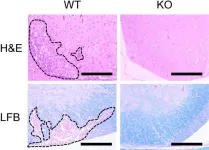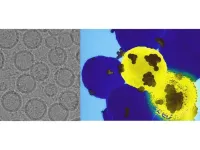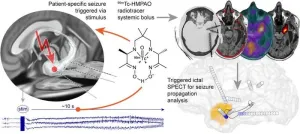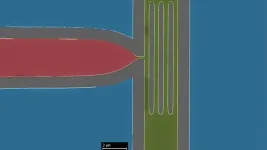(Press-News.org) A new study highlights a potential therapeutic target for immune-related disorders, such as multiple sclerosis and asthma.
A new study has shed light on the importance of the protein STAP-1 in activating certain immune cells. Understanding the role of STAP-1 in these cells could give researchers a better glimpse into immune-related disorders and ways to treat them.
The researchers found that STAP-1 plays an important role in the activation of T cells, which are white blood cells that play a critical role in defending the body against infections and maintaining overall health. T cells are adept at recognizing foreign molecules that trigger an immune response (antigens) and mounting targeted responses to eliminate pathogens, such as bacteria and viruses.
The study, published in The Journal of Immunology, investigated how STAP-1 influences immune response. The researchers showed that it acts as an intermediary, facilitating communication between different proteins within the cells and enabling the transmission of signals from one molecule to another.
"Our findings provide valuable insights into the molecular mechanisms underlying T cell activation and the development of immune disorders,” says Tadashi Matsuda, a Hokkaido University professor who led the study. “We found that STAP-1 plays an important role in regulating immune responses, particularly in the activation and functioning of T cells.”
T cells need two signals to become activated and initiate an immune response. The first signal involves the recognition of antigens presented by other cells, known as antigen-presenting cells. The antigens are recognized by the T cell receptor, a protein complex found on the surface of T cells. The second signal consists of co-stimulatory signals provided by molecules on the antigen-presenting cells.
The researchers found that STAP-1 helps T cells communicate and respond to signals, particularly those triggered by the T cell receptor. T cells lacking STAP-1 had trouble receiving and transmitting signals properly, reducing the production of certain immune molecules called cytokines. Cytokines can cause inflammation or autoimmune diseases, in which the immune system mistakenly attacks healthy tissues and organs.
The team also found that STAP-1 interacts with other proteins involved in T cell signaling, forming a complex network that helps regulate T cell activity. They observed that cells lacking STAP-1 had less inflammation in models of diseases like multiple sclerosis and asthma, suggesting that STAP-1 may be involved in the development of these conditions.
These findings represent a significant step towards understanding immune system regulation. Future research can build on this work by exploring the potential of STAP-1 as a therapeutic target for treating immune-related disorders.
END
Key protein linked to immune disorders
2024-03-12
ELSE PRESS RELEASES FROM THIS DATE:
COVID-19 had greater impact on life expectancy than previously known, but child mortality rates continued to decline during the pandemic
2024-03-12
**Embargo: 23:30 UK, 7:30 p.m. ET March 11, 2024**
***Please note the unusual embargo time for the United States due to daylight savings time***
Global Burden of Disease
COVID-19 had greater impact on life expectancy than previously known,
but child mortality rates continued to decline during the pandemic
A new study published in The Lancet reveals never-before-seen details about staggeringly high mortality from the COVID-19 pandemic within and across countries. Places such as Mexico City, Peru, and Bolivia had some of the largest drops in life expectancy from 2019 to 2021. The research, which presents updated ...
NSF CAREER Grant awarded to Dr. Jordon Gilmore Associate Professor of Bioengineering Clemson University
2024-03-12
Congratulations to Dr. Jordon Gilmore for receiving the prestigious NSF CAREER Award! The project is titled: "A Multi-phase Biosensing Approach towards Point-of-Care Evaluation of Pseudomonas aeruginosa Virulence in Infected Chronic Wounds". The project is in perfect alignment with the ADAPT in SC NSF Award. Dr. Gilmore is a co-leader of the the Explainable AI-Enabled Biomedical Devices for Diagnostics and Planning Applications, and the leader of the Broadening Participation and Diversity project areas of ADAPT in SC. In addition, he serves as a member of the ...
How do neural networks learn? A mathematical formula explains how they detect relevant patterns
2024-03-12
Neural networks have been powering breakthroughs in artificial intelligence, including the large language models that are now being used in a wide range of applications, from finance, to human resources to healthcare. But these networks remain a black box whose inner workings engineers and scientists struggle to understand. Now, a team led by data and computer scientists at the University of California San Diego has given neural networks the equivalent of an X-ray to uncover how they actually learn.
The researchers found that a formula used in statistical analysis provides a streamlined mathematical description of how neural networks, such as GPT-2, a precursor ...
Vaccine monitoring crucial as SARS-CoV-2 variants continue to evolve
2024-03-12
Researchers at the Francis Crick Institute and the National Institute for Health and Care Research Biomedical Research Centre at UCLH have highlighted the importance of continued surveillance of emerging SARS-CoV-2 variants and vaccine performance as the virus continues to evolve.
Published today as a research letter in The Lancet, their study compared the newer monovalent COVID vaccine, which specifically targets the XBB variant of Omicron (as recommended by the World Health Organisation), with older bivalent vaccines containing a mix of an Omicron variant and the original strain of COVID-19, which ...
Q&A: How Instagram influencers profit from anti-vaccine misinformation
2024-03-12
While Instagram might have a reputation for superficiality — a realm of exquisitely filtered images — it is now eclipsing other social media as a news source. The platform is increasingly filled with information, some of it pernicious and distributed via influencers.
Researchers at the University of Washington studied three prominent Instagram influencers spreading anti-vaccine misinformation as a route to profit. Each account occupies what lead author Rachel E. Moran, a UW senior research scientist at the Center for an Informed Public (CIP) and staff researcher in the ...
Nancy Brown recognized as one of Modern Healthcare’s ‘Top Women Leaders’
2024-03-12
DALLAS, March 11, 2024 — Nancy Brown, Chief Executive Officer of the American Heart Association, a global force for healthier lives for all and celebrating one hundred years of lifesaving service, has been recognized by Modern Healthcare as one of the Top Women Leaders for 2024.
The publication’s recognition program acknowledges and honors women executives from all sectors of the healthcare industry for their contributions to care delivery improvement, health equity, policy and gender equity in healthcare leadership.
Since 2008, Brown has served as CEO of the Association, which is celebrating its 100th birthday in 2024. Awardees were selected based ...
India's water problems set to get worse as the world warms
2024-03-12
Winter storms that provide crucial snow and rainfall to northern India are arriving significantly later in the year compared to 70 years ago, a new study has found, exacerbating the risk of catastrophic flooding while also reducing vital water supplies for millions of Indians.
The cyclonic storms, known as western disturbances, typically bring heavy snow to the Himalayas from December to March. This snowpack slowly melts in spring, providing a steady supply of irrigation water for wheat and other crops downstream.
The study, published today (Tuesday, 12 March 2024), in the journal Weather and ...
GPS nanoparticle platform precisely delivers therapeutic payload to cancer cells
2024-03-11
UNIVERSITY PARK, Pa. — A newly developed “GPS nanoparticle” injected intravenously can home in on cancer cells to deliver a genetic punch to the protein implicated in tumor growth and spread, according to researchers from Penn State. They tested their approach in human cell lines and in mice to effectively knock down a cancer-causing gene, reporting that the technique may potentially offer a more precise and effective treatment for notoriously hard-to-treat basal-like breast cancers.
They published their work today (March 11) in ACS Nano. They also filed a provisional application to patent the technology ...
New method for triggering and imaging seizures can help guide epilepsy surgery
2024-03-11
Researchers have developed a new method for triggering and imaging seizures in epilepsy patients, offering physicians the ability to collect real-time data to tailor epilepsy surgery. In contrast to previous practice, where physicians from neurology and nuclear medicine had to wait for hours to days in hopes of capturing the onset of a seizure, the new method is convenient, spares resources, and is clinically feasible. This research was published in the March issue of The Journal of Nuclear Medicine.
People with epilepsy and seizures who do not respond to medication are often helped by brain surgery. The goal ...
Giving particle detectors a boost
2024-03-11
Device could help facilitate the operation of new particle colliders, such as the Electron-Ion Collider.
In particle colliders that reveal the hidden secrets of the tiniest constituents of our universe, minute particles leave behind extremely faint electrical traces when they are generated in enormous collisions. Some detectors in these facilities use superconductivity — a phenomenon in which electricity is carried with zero resistance at low temperatures — to function.
For scientists to more accurately observe the behavior of these particles, these weak electrical signals, or currents, need ...




